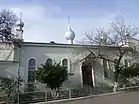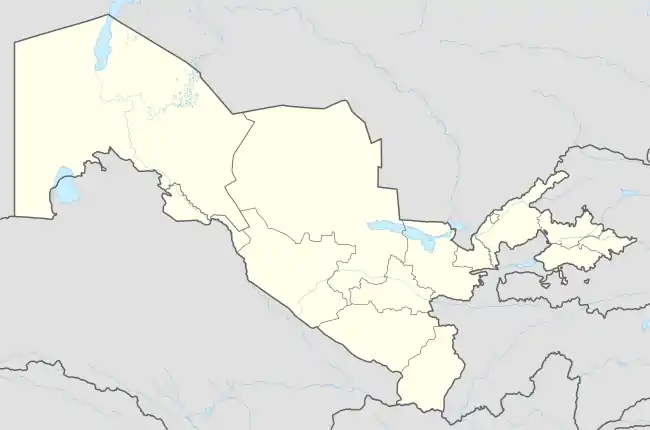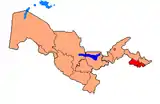Kokand
Kokand (Uzbek: Qo‘qon, Қўқон, قوقان; Russian: Кока́нд; Persian: خوقند, romanized: Xuqand; Chagatai: خوقند, Xuqand; Kyrgyz: Кокон, romanized: Kokon; Tajik: Хӯқанд, romanized: Xökand) is a city in Fergana Region in eastern Uzbekistan, at the southwestern edge of the Fergana Valley. The population of Kokand on April 24, 2014 was approximately 187,477. The city lies 228 km (142 mi) southeast of Tashkent, 115 km (71 mi) west of Andijan, and 88 km (55 mi) west of Fergana. It is nicknamed "City of Winds". Kokand's name derives from the well-known tribal family group of "Kokan" who belong to the Kongrat tribe of Uzbeks.[1]
Kokand
Qo‘qon / Қўқон | |
|---|---|
 .jpg.webp) .jpg.webp)   | |
 Kokand Location in Uzbekistan | |
| Coordinates: 40°31′43″N 70°56′33″E | |
| Country | |
| Region | Fergana Region |
| Government | |
| • Hokim | Ma'rufjon Usmonov |
| Area | |
| • Total | 40 km2 (20 sq mi) |
| Elevation | 409 m (1,342 ft) |
| Population (01.07.2020) | |
| • Total | 254 700 |
| Time zone | +5 |
| Postal code | 150700 |
| Website | qoqon |
Kokand is at the crossroads of the two main ancient trade routes into the Fergana Valley, one leading northwest over the mountains to Tashkent, and the other west through Khujand. As a result, Kokand is the main transportation junction in the Fergana Valley.
History
The town of Kokand is one of the oldest towns in Uzbekistan and is situated in the western part of Fergana Valley. In the chronicles of the 10th century, the first written documents concerning town of Hukande, Havokande (old names of the town). In the 13th century, like most of Central Asian towns, the Mongols ruined the city. The town is a significant hub for trading on the Silk Route.[2]
Kokand has existed since at least the 10th century, under the name of Khavakand, and was frequently mentioned in traveler's accounts of the caravan route between South Asia and East Asia. The Han Dynasty of China conquered the entire city in the 1st Century B.C. Later, the Arabs conquered the region from Tang Empire. The Mongols destroyed Kokand in the 13th century.
The present city began as a fort in 1732 on the site of another older fortress called Eski-Kurgan. In 1740, it became the capital of an Uzbek kingdom, the Khanate of Kokand, which reached as far as Kyzylorda to the west and Bishkek to the northeast. Kokand was also the major religious center of the Fergana Valley, boasting more than 300 mosques.
Imperial forces of Russian Empire under Mikhail Skobelev captured the city in 1883 which then became part of Russian Turkistan. After joining of Kokand and the whole of Central Asia, in general, to the Empire, peace and order came to the region for 40 years. During World War I, two revolutions happened in the Russian Empire. Separatists took advantage of the situation to destabilize the city and to prevent revolutionary changes. So it was the capital of the short-lived (72 days) (1917–18) anti-Bolshevik Provisional Government of Autonomous Turkistan (also known as Kokand Autonomy).[3] They sought co-operation from Ataman Dutov and Alash Orda. However, their emissary to the Amir of Bukhara achieved little.
It is worth to note that the modern city was mainly developed since its joining to Russian Turkistan.
Main sights
The Palace of Khudayar Khan
The Palace of Khudayar Khan was built between 1863 and 1874 by ruler Muhammad Khudayar Khan, the palace is the most impressive sight in Koland. When it was built, American diplomat Eugene Schulyer described it as being "much larger and more magnificent than any other [palace] in Central Asia.”[4]
Khudayar Khan commissioned architect Mir Ubaydullo to build him a royal residence with 113 rooms set around seven courtyards.[5] The ruler wanted his mother to live in one of the palace’s grand buildings, but she refused and set up her yurt in a courtyard.[6]
The facade of the building is decorated with mosaic tiles and an Arabic inscription above the entrance. The inscription translates as “Seid Mohammad Khudayar Khan: the great ruler”.
Most of the palace, including its harem, was demolished by the Soviets, but 19 rooms remain.[7] These are open to the public, and the interiors have been partially restored.[5] They show a combination of Russian and traditional Uzbek styles, and the exquisite craftsmanship of Kokand’s 19th century artisans. It is possible to view the palace’s collection of Chinese ceramics on request.[5]
Juma Mosque
Kokand’s Juma Mosque (Friday Mosque) is located on Chursu Square in the historic Icheri Sheher part of the city. It was built between 1809-1812 by Muhammad Umar Khan, who was ruler of Kokand from 1810 until his death in 1822.
The mosque is built around a large courtyard and has a 100m long iwan supported on 98 redwood columns, which are ornately carved and were brought from India.[5] The minaret is 22m high.[8]
Although intended to be Kokand’s main place of worship, the Juma Mosque remained shut for most of the 20th century. It then reopened after much needed restoration in 1989 and now houses a small museum of applied arts with displays of embroideries and ceramics.[9]
Amin Beg Madrassah
The Amin Beg Madrassah, a religious school, was built in the 1830s for a son of Madali Khan, the khan of Kokand from 1822-1842. The madrassah has a beautifully tiled facade, which was restored in 1913 by a craftsman called Khomol Khozi. For this reason, the madrassah is often called the Khomol Khozi Madrassah.[10] Today, the building houses a small museum and a shop, but the tiles and the carved wooden columns are still impressive to look at.
Hamza Museum
Built in 1989, the Hamza Museum is named after Hamza Hakimzade Niyazi, a Soviet hero who was born in Kokand. Hamza was Uzbekistan’s first national poet and the founder of Uzbek social realism, and the museum was opened to commemorate the centenary of his birth.[10] The museum houses general exhibits about life in Kokand, and also has artefacts relating to a variety of dramatists, propagandists, and writers.[5]
Additional Sites
There are three other historic madrassahs in Kokand. The 19th-century Shaib Mian Hazrat Madrasa has a small museum dedicated to the poet Mohammad Amin Muqimi (1850-1903).[11]
The Narbutabey Madrassah was built in the 1790s. Its graveyard includes the tomb of Muhammad Umar Khan and his wife, the famous Uzbek poet Nodira.[12] Known as the Modari Khan Mausoleum, it is ornately decorated with glazed blue mosaic tiles. Unlike the other madrassahs in Kokand which were closed by the Soviets, the Narbutabey Madrassah remained active as a place of Quranic study until 2016.[10]
The last madrassah is the Dasturkahanchi Madrasa. It was built in 1833 as a school for boys, but it is now a training centre where girls learn embroidery.[12]
- Dakhma-I-Shokhon, a necropolis of the Kokand Khans from the 1830.
Education and culture
A number of madrasahs can be found with the city. Kokand made contribution to Islam. It is also home to a number of notable hanafi scholars, such as Abdulhafiz Al-Quqoniy and Yorqinjon Qori Al-Quqoniy.
There are 2 institutes, 9 colleges and lyceums, 40 secondary schools, 5 musical schools, a theater, and 20 libraries. There are 7 historical and house museums located in Kokand.[13]
The first International Handicrafters Festival took place in Kokand in September 2019. It was hosted by the Uzbekistan Handicraft Association, and the guest of honour was Rosy Greenlees, President of the World Crafts Council.[14] More than 600 creatives from 70 countries participated.
The festival was created to enable artisans from around the world to demonstrate and sell their products, as well as to network and further develop their skills.[15] The festival included conference sessions dedicated to developing hand craftsmanship.[16] The crafts on display included musical instruments, painting, ceramics, textiles, metalwork, and woodwork.
It is planned that the festival will be a biennial event, and it will next take place in 2021.[17]
Economy
The black market provides nearly 75% of the income generated in the borders of the city. This includes retail, groceries, employment, money exchange, agriculture and manufacturing of many goods. A large part of the population works as small business owners in outdoor markets.
Kokand is a center for the manufacture of fertilizers, chemicals, machinery, and cotton and food products. Over the last two decades, new districts and public buildings have been created in the city as well as many houses, shops, cafes, restaurants and other private sector ventures. Kokand is an education center with one institute, nine colleges and lyceums, and numerous museums.
Notable people
- Muhammad Sharif Gulkhani, poet and satirist
- Ziroatkhon Hoshimova, First Lady of Uzbekistan
- Ida Mayrin (born 1997), Israeli Olympic rhythmic gymnast
- Yodgor Nasriddinova, Uzbek-Soviet engineer and communist party official
- Abdulla Qahhor, Uzbek writer
- Abraham Resnick, rabbi
- Serhiy Shkarlet, Ukrainian politician[18]
References
- Географические названия мира: Топонимический словарь. — М: АСТ. Поспелов Е.М. 2001.
- "Kokand, Uzbekistan". Retrieved January 30, 2021.
- The Politics of Muslim Cultural Reform, Jadidism in Central Asia by Adeeb Khalid, Oxford University Press, 2000
- "Khudoyar-Khan Palace, Kokand, Uzbekistan". uzbek-travel.com. Retrieved 2020-10-31.
- Ibbotson, Sophie (2020). Uzbekistan. United Kingdom: Bradt Guides Ltd. p. 153. ISBN 9 781784 771089.
- "Khudoyar-Khan Palace, Kokand, Uzbekistan". uzbek-travel.com. Retrieved 2020-10-31.
- "Khudoyar-Khan Palace, Kokand, Uzbekistan". uzbek-travel.com. Retrieved 2020-10-31.
- "Jami Mosque Museum | Kokand, Uzbekistan Attractions". Lonely Planet. Retrieved 2020-10-31.
- "Jami Mosque Museum | Kokand, Uzbekistan Attractions". Lonely Planet. Retrieved 2020-10-31.
- Macleod; Mayhew (2019). Decouverte Ouzbekistan. Geneva: Guide Olizane.
- Ibbotson, Sophie (2020). Uzbekistan. United Kingdom: Bradt Guides Ltd. p. 154. ISBN 9 781784 771089.
- Ibbotson, Sophie (2020). Uzbekistan. United Kingdom: Bradt Guides Ltd. p. 155. ISBN 9 781784 771089.
- More on Kokand
- Loop. "Central Asia awakes! The Festival of Handcrafters, Kokand, Uzbekistan". Garland Magazine. Retrieved 2020-10-31.
- Admin, W. C. C. "Apply now: The First International Handicrafters Festival Kokand 2019 | World Crafts Council Europe". Retrieved 2020-10-31.
- Admin, W. C. C. "Apply now: The First International Handicrafters Festival Kokand 2019 | World Crafts Council Europe". Retrieved 2020-10-31.
- sariq-qiz (2019-09-29). "International Handicrafters Festival Kokand / Internationales Handwerker Festival Kokand". sariqqiz (in German). Retrieved 2020-10-31.
- (in Ukrainian) From Yanukovych to Zelensky through Poroshenko. Who is the head of the Ministry of Education Serhiy Shkarlet, Ukrayinska Pravda (13 October 2020)
